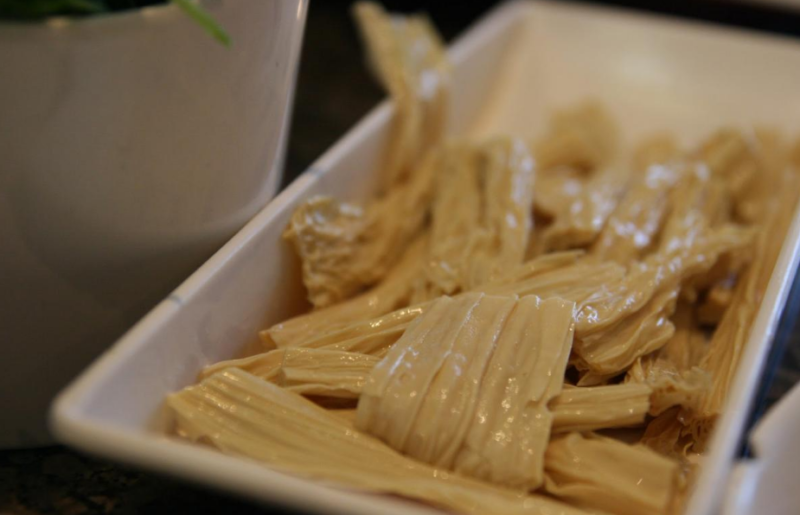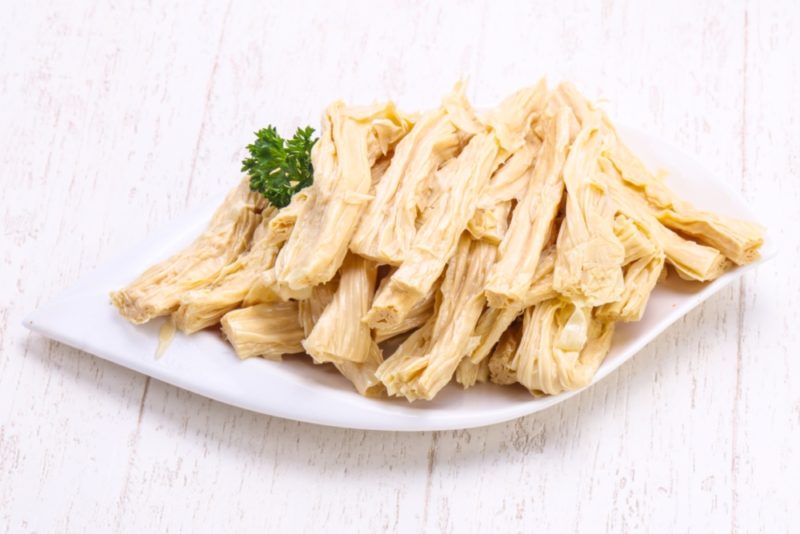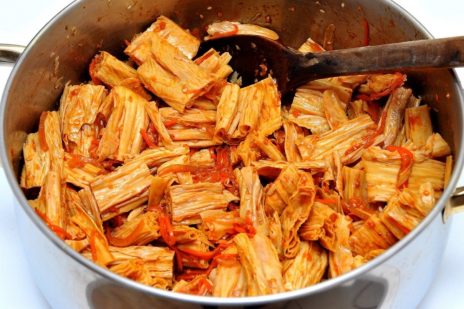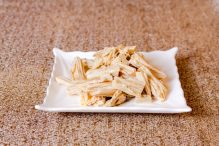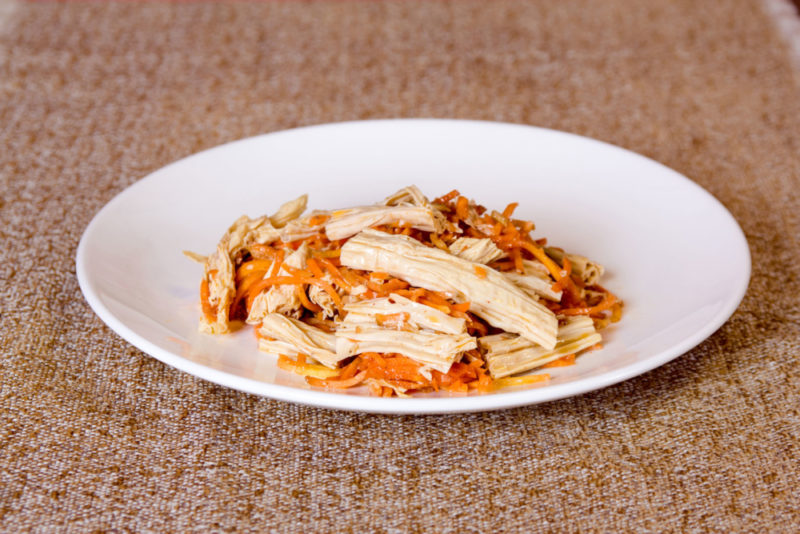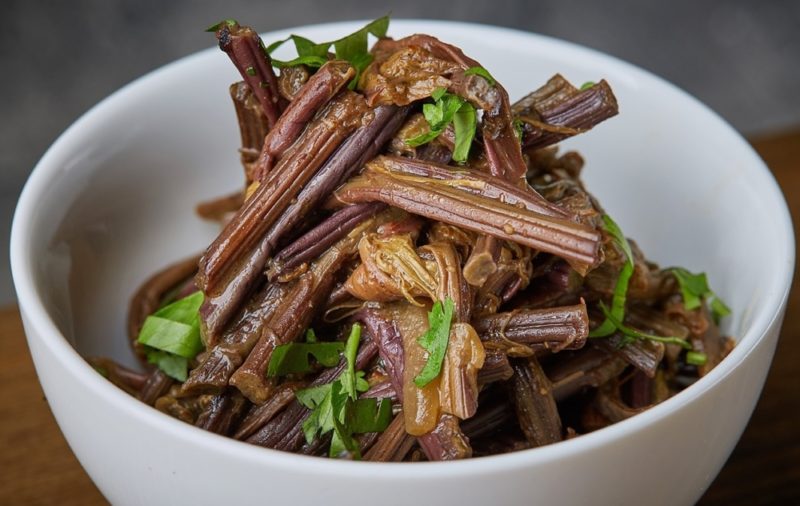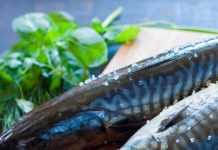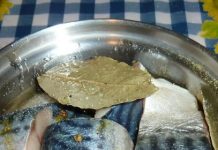What is asparagus made of in Korean? Contrary to popular belief, the main ingredient has nothing to do with the famous vegetable with green shoots. Asparagus for popular Korean dishes is a soybean semi-finished product of East Asian cuisine, wrinkled dry sticks. In China they are called "fuju" or "fupi", for the Japanese and Koreans it is "yuba." In Russia, this product is used to be called “asparagus”.
Material Content:
What Korean Asparagus Is Made From
The technology for producing fuju has been developed for centuries. Production consists of several stages.
- Fresh soybeans are soaked for several hours, then ground.
- Using special equipment, protein is separated for the manufacture of bean curd. In this case, milk is formed.
- The raw material is boiled. Soy milk stews for a long time at a certain temperature, forming a foam on the surface in the form of a dense film with a high percentage of fat - fupi.
- The layer is collected and suspended vertically for drying. Fupi stretches out and turns into a fibrous and shriveled fuju tube.
- The soy milk tow is removed, rolled, and dried in a horizontal position. Then break into pieces.
Dry long sticks in transparent packaging are sold with the trademark Fuzhu, or Zhiyuan. Usually one standard package weighs 500 g.
Dried fuju or simply soaked in water is almost tasteless. Soy asparagus is saturated with the aroma and taste of marinades, spices and other ingredients.
Calorie Fuju
Soy asparagus is a protein concentrate.
The balance of dry fuju BJU looks like this:
- proteins - 56.3;
- fats - 24.9;
- carbohydrates - 18.8.
For a 2000 kcal diet, fuju covers almost 70% of the daily protein intake.
The calorie content of asparagus in Korean in Internet sources is represented by various data and ranges from 200 to 385 kcal per 100 g of dry fuju.
The nutritional value of finished asparagus depends on the recipe. Fried fuju in oil becomes a very nutritious food. The body will receive far fewer calories from pickled asparagus.
The benefits and harms of the product
Korean asparagus has a valuable selection of vitamins and minerals. It contains vitamins of group B, ascorbic acid, phosphorus, zinc, potassium, magnesium and many other useful substances.
The main value of soy asparagus for human health is phytoestrogens. Reasonable and regular consumption of fuju is especially recommended for women during the premenopausal period.
A protein product with hormone stimulating qualities has the ability to:
- stimulate cell rejuvenation;
- prevent the risk of malignant tumors;
- prevent the occurrence of osteoporosis.
Another valuable ingredient in asparagus is lecithin. This is a complex of phospholipids, a building material for cell membranes. His participation in the metabolic processes of the body strengthens the nervous system, improves the activity of the cardiovascular system, and accelerates the metabolism of fats. Therefore, nutritionists recommend fuju to people with overweight problems, and cardiologists recommend it to patients with pathologies of the heart and blood vessels. The presence of asparagus in the menu in Korean reduces the concentration of cholesterol in the blood and prevents the risk of stroke.
Like any product with a set of active elements, soy asparagus is both beneficial and harmful.
- Plant hormones inhibit the activity of the thyroid gland, so fuju is contraindicated in its hypofunction.
- The use of asparagus is also not recommended for patients with kidney diseases: the soy product contains a significant amount of oxalic acid, which provokes the formation of stones.
- People with pancreatic diseases need to use asparagus with great care. An excess of East Asian soy dishes on the menu can negatively affect the condition of the vulnerable organ. Having a history of pancreatitis, it is better to refuse fuju.
Best Korean Asparagus Recipes
Fuju has a fairly low calorie content and a pleasant taste. Nutritionists are advised to include the dish in the diet for weight loss and a healthy variety of menus.
Nutritionists believe that asparagus is better for lunch or dinner: in the afternoon, vegetable protein is absorbed much better.
Asparagus is used as a separate dish, or as one of the ingredients. Recipes with soybean semi-finished products came to us from East Asian countries - China, Japan, Korea and India.
Korean asparagus recipes are light and quick to cook. To get a tasty snack, you need no more than half an hour.
But first, fuju needs to be prepared:
- Dip in cool water for about 3 to 4 hours.If you don’t have time, but you want asparagus, you can hold the dried semi-finished product in boiling water for a couple of minutes. Asparagus will swell instantly, but its taste will be inferior to that of a product processed in a "cold" way, and useful properties may be completely lost.
- Rinse the product well after soaking.
- Squeeze the asparagus and cut into pieces of the usual length (3 - 5 cm). To make fuju more aesthetically pleasing, it is advisable to cut it diagonally.
Now the soya harvest is ready for further manipulations to become a delicious Korean-style appetizer.
Korean style asparagus
This is the traditional and most famous dish of Asian cuisine.
To make asparagus according to a popular recipe, you will need these products:
- dry fuzhu - 300 g;
- garlic - 4 large cloves;
- onions - 2 pcs. medium size;
- soy sauce - 4 - 5 tbsp. l .;
- seasonings and spices to taste;
- vinegar, salt and sugar to taste;
- vegetable oil - for frying vegetables.
Cooking:
- Prepared fuju cut into equal slices.
- Chop and fry the onion.
- Crush the garlic cloves with a press.
- In a separate container, mix soy sauce and vinegar.
- Combine the garlic with the hot contents of the pan and mix. We need onions with butter.
- Pour everything into asparagus, salt, add spices, sugar, soy vinegar.
- Mix well and put in the refrigerator.
Now the taste of the salad depends on your exposure. The longer the asparagus is cooled in Korean after cooking - the more saturated with the aroma of marinade and seasonings, the tastier it becomes. The optimal period is 3 to 5 hours.
Korean asparagus with carrots
The classic taste of pickled fuju can be supplemented with vegetables. For example, carrots.
For this Korean asparagus recipe you will need:
- fuzhu - 0.5 standard packaging;
- onion - 1 large;
- garlic - 3 cloves;
- green onion feathers - 1 small bunch;
- carrots - 400 g;
- spices and seasonings - to taste (red ground pepper and coriander - required);
- soy sauce and vinegar 70% - one incomplete Art. l .;
- any vegetable oil to taste.
Cooking method:
- Prepare fuju (method above).
- Grind the carrots in the "Korean" way.
- Salt, pepper, add vinegar. Set aside for 25 minutes.
- Chop onion and garlic. Fry, add slices of asparagus, soy sauce and coriander.
- Fry the mass over low heat for 5 to 7 minutes.
- Combine with carrots, mix, remove for insisting. In the refrigerator, the salad should spend from three hours to a day.
- Sprinkle with green onions when serving.
The appetizer can be supplemented with sesame seeds. It must be fried in advance in oil until a golden hue appears and add with carrots.
This salad is best eaten chilled. In this state, it is considered the most delicious. Although, as you know, everyone decides for himself.
Mushroom asparagus
Korean appetizer with mushrooms is one of the special options for cooking asparagus.
Ingredients:
- dry fuzhu - 300 g;
- fresh champignons - 400 g;
- onions - 2 pcs.;
- ready-made Korean seasoning and other spices to taste;
- salt;
- refined oil.
Cooking:
- Prepare asparagus (method above), squeeze and cut into equal slices.
- Cut the mushrooms into plates along the legs, and the onions into thin rings.
- Fry the mushrooms for 20 minutes.
- Add onion to the pan and lightly fry it with mushrooms.
- Drain the hot oil from the pan into a bowl with asparagus pieces, mix.
- Put the asparagus under oppression or press for an hour and a half.
- Then salt the product, mix with the "Korean" seasoning, mushrooms and onions.
In order for the dish to acquire a rich taste, it is better to place the asparagus in a sealed container, refrigerate and forget about it for 4 - 5 hours.


